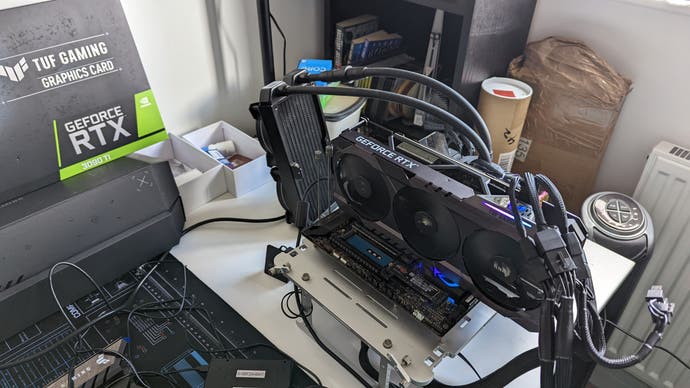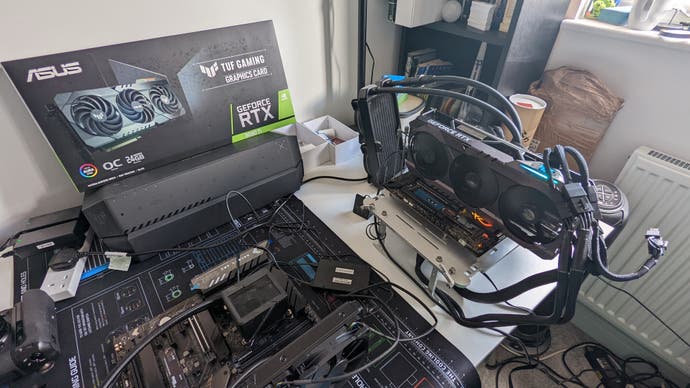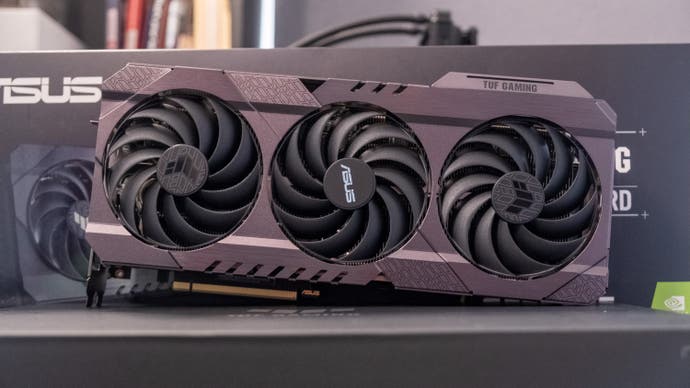Nvidia GeForce RTX 3090 Ti review: Olympian power and performance
Zeus would be proud.
Nearly two years ago, we called the Nvidia GeForce RTX 3090 a Titan in all but name, a prosumer graphics card that makes sense as a cheaper alternative to professional Quadros while also delivering better gaming performance than any consumer alternative. Now the RTX 3090 Ti has arrived, placing it above the Titans and firmly into the realm of the Olympians - in terms of performance, power consumption and price tag.
The RTX 3090 Ti retails for £1879 in the UK and $1999 in the US, making it a hefty £480/$500 more expensive than its predecessor - that's a 33 percent markup on what is already an expensive part. In exchange, you get a fully-unlocked GA102 die with 2.4 percent more CUDA cores, a 9.4 percent higher boost clock, a 7.7 percent higher memory clock and a 29 percent higher rated power draw. That suggests we'll see a faster card than the vanilla 3090, but getting anywhere close to 33 percent extra performance to make the premium worthwhile seems unlikely at this stage.
At 450W, you'll need an 850W power supply or better to tame the beast - Nvidia note that a 450W PCIe 5.0 power cable or greater will deliver enough juice, or three of the more standard 8-pin PCIe inputs. That's the Nvidia Founders Edition card, but custom boards are available with higher power targets - some rated near the 525W limit (!) of what's deliverable via the PCIe connector (75W) and three auxiliary inputs (3x150W), with a 1000W PSU recommended (!!).
| RTX 3090 Ti | RTX 3090 | RTX 3080 Ti | 2080 Ti | 1080 Ti | |
|---|---|---|---|---|---|
| GPU | GA102 | GA102 | GA102 | TU102 | GP102 |
| CUDA cores | 10752 | 10496 | 10240 | 4352 | 3584 |
| VRAM | 24GB GDDR6X | 24GB GDDR6X | 12GB GDDR6X | 11GB GDDR6 | 11GB GDDR5X |
| Memory Bus | 384-bit | 384-bit | 384-bit | 352-bit | 352-bit |
| Bandwidth | 1008GB/s | 936GB/s | 912GB/s | 616GB/s | 484GB/s |
| Boost Clock | 1860MHz | 1695MHz | 1665MHz | 1545MHz | 1582MHz |
| TDP | 450W | 350W | 350W | 250W | 250W |
| Die Size | 628mm² | 628mm² | 628mm² | 754mm² | 471mm² |
| Transistors | 28B | 28B | 28B | 18.6B | 11.8B |
The subject of our review is an Asus Tuf Gaming RTX 3090 Ti OC Edition provided by British tech retailer Box. This model boosts 90MHz higher than the reference spec, 1950MHz, and comes with two HDMI 2.1 ports and three DisplayPort 1.4 ports. It sports a 16-pin PCIe 5.0 power input, but a 16-pin to triple 8-pin adapter is provided in the box to hook it up to traditional power supplies. Elsewhere, it's a standard Asus Tuf Gaming design, with a thick 3.2-slot design, three axial fans, aluminium fins that run the length of the board (including a dedicated heatsink for the VRAM) and a sturdy aluminium shroud with RGB elements. The whole package measures 326x140x63mm (12.8 inches long, 5.5 inches wide and 2.5 inches thick), so you'll need a capacious case or an open-air test bench to accommodate this card.


Our test set-up remains unchanged from our past GPU reviews, but here's a quick summary if you're just tuning in now. We settled on a Core i9 10900K system as this provided the best out-and-out gaming performance when current-gen GPUs launched back in 2020, backed with an Asus Maximus 12 Extreme Z490 motherboard, dual-channel G.Skill Trident-Z Royal DDR4-3600 CL16 memory and a 2TB Samsung 970 Evo Plus NVMe drive from Box. To keep our CPU performance constant, we've locked it to 5GHz on all cores and kept it cool with a 240mm Eisbaer Aurora liquid cooler.
Now that you're familiar with our test bed and have a good overview of the cards themselves, let's see just how well this RTX 3090 Ti performs.
Nvidia GeForce RTX 3090 Ti analysis
- Introduction and hardware analysis [This Page]
- Doom Eternal, Control, Borderlands 3, Shadow of the Tomb Raider - Game Benchmarks Part 1
- Death Stranding, Far Cry 5, Hitman 2 - Game Benchmarks Part 2
- Metro Exodus, Dirt Rally - Game Benchmarks Part 3
- Control, Metro Exodus, Battlefield 5 - RT game benchmarks
- Nvidia GeForce RTX 3090 Ti - the Digital Foundry verdict








